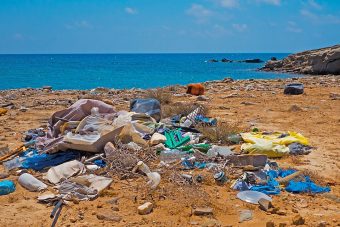
The coast of South Africa’s Kwazulu-Natal province looks like it was pulled from a postcard, with wide, sandy beaches stretching for some 600 kilometres. International and local tourists flock here in normal times, drawn to the warm Indian Ocean waters for surfing, relaxation, and glimpses of spectacular wildlife, like loggerhead turtles.
But heavy rains can transform this beautiful coast in a flash. Downpours accelerate the flow of polluted upstream rivers, sending their litter cascading into the sea, including around the city of Durban. After a storm, heaps of plastic bags and bottles pile up on Durban’s shores with the current transporting some rubbish hundreds of kilometers down the coast.
What’s happening to Kwazulu-Natal’s beaches is part of a larger marine litter crisis in South Africa. Every year, between 90,000 and 250,000 tonnes of rubbish enter the oceans that surround the country. This marine litter can damage ship engines and propellers. It becomes entangled in nets and other fishing equipment. It drives away tourists. It’s often ingested by birds, mammals, and fish, causing them to choke or become sick. And it can find its way into the human food chain.
But just where is all this waste coming from?
“Eighty per cent of marine litter originates on land, mediated through flash floods and river inputs,” said Jared Bosire, Project Manager with the United Nations Environment Programme’s (UNEP) Regional Seas Programme. “Therefore, if we want a clean ocean, we must change our behavior on shore and link the solution to the source, which is upstream.”
A new project driven by the South African Department of Environment, Forestry and Fisheries aims to do exactly that. The department is joining forces with local officials, non-profit groups, like Coastwatch and Durban Green Corridors, and Plastics SA, a privately-owned company, to stem the flow of marine litter in five river systems in Kwazulu-Natal. Through increased litter collection and community-led waste sorting and recycling, the department will reduce litter generation at its source, thereby lessening the amount of pollution that reaches the ocean.
Litter booms, barriers that collect floating debris, will be installed in the uMngeni, uMlazi, uMbilo, uMhlatuzana, and aManzimnyama rivers. Communities will help clean out the booms on a daily basis during the two-year project. The booms have the added benefit of trapping invasive species, like the exotic water hyacinth, before they take root in waterways.
The department will also implement a waste sorting and recycling programme in one community per river. One possibility being considered is the idea of “swop-shops” where community members can trade the recyclable litter for essentials, said Yazeed Petersen, a Project Manager from the South African Department of Environment, Forestry and Fisheries. “Integrating these shops into the project will further encourage communities to become involved in litter collection.”
Douw Steyn of Plastics SA agreed. “We need to ensure that value is given to waste plastic so that it can contribute to the circular economy. Recyclers cannot get enough material, so there is enormous potential for those willing to collect litter.”
The project is designed to help South Africa achieve its targets under Sustainable Development Goal 14.1, under which the country committed to preventing and reducing marine pollution by 2025, as well as Sustainable Development Goal 6.3 to improve water quality by 2030 through reducing pollution.
The initiative is being funded by the Global Environment Facility through the Implementation of the Strategic Action Programme for the Protection of the Western Indian Ocean from Land-Based Sources and Activities, executed by the Nairobi Convention. This project will reduce land-based stresses on this environment by protecting critical habitats, improving water quality, and managing river flows. The convention, part of UNEP’s Regional Seas Programme, serves as a platform for governments, civil society and the private sector to work together for the sustainable management and use of the Western Indian Ocean.
Source: unep.org



